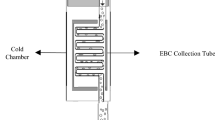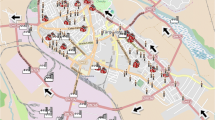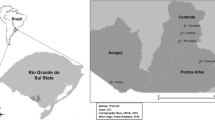Abstract
Objective
The purpose of this study is to characterize the levels of particulate matter (PM10) and heavy metals (HMs) such as Cd and Pb, compare blood HMs (B-HMs) and high-sensitivity C-reactive protein (hs-CRP) levels and examine the prevalence of allergic diseases among general population living near the Gwangyang industrial complex (GIC).
Methods
A survey and environmental and biomonitoring sample collection were done as part of a study involving 300 residents who were 20 years of age and older. To compare, the participants were split into two groups: those with physician-diagnosed allergic diseases (PDAD) and without physician-diagnosed allergic diseases (non-PDAD). ICP/MS and GF/AAS were used to measure the HMs in PM10 and B-HMs. SPSS version v25.0 was used to analyze the data to identify risk factors between exposure and diseases.
Results
The levels of three air pollutants close to road transport (≤ 50 m) and industrial complex areas (≤ 5 km) were higher than those over 100 m and 15 km from each source. The GMs for the PDAD group were 0.97 μg/L in B-Cd and 1.04 μg/dL in serum hs-CRP, significantly higher than 0.86 μg/L and 0.71 μg/dL in the non-PDAD group. In the PDAD, the mean B-Pb in males was significantly higher than that in females. The mean B-Pb among locals close to the GIC area (≤ 5 km) was significantly higher than that over 15 km. We found several risk factors, including gender, daily average housing, and distance to road transport, were significantly related to the increased levels of B-HMs.
Conclusions
A significant association was found between higher levels of environmental exposure to PM10 and HMs, B-HMs and hs-CRP levels with an increased prevalence of PDAD. This study provided the information required to carry out a risk assessment and take measures to mitigate the potential health risk in the GIC area.

Similar content being viewed by others
References
Park JH, Park YY, Lee E et al (2020) Analysis on the effects of particular matter distribution on the number of outpatient visits for allergic rhinitis. Korean J Health Policy Manag 30(1):50–61
Ha J, Lee SW, Yon DK (2020) 10-year trends and prevalence of asthma, allergic rhinitis, and atopic dermatitis among the Korean population, 2008–2017. Clin Exp Pediatr 63(7):278–283
Lee J, Oh I, Kim M et al (2015) Correlation between allergic rhinitis prevalence and immune responses of children in Ulsan: a case-control study. Korean J Environ Health Sci 41(4):249–258
Lee J, Yun S, Oh I et al (2020) Impact of environmental factors on the prevalence changes of allergic diseases in elementary school students in Ulsan, Korea: a longitudinal study. Int J Environ Res Public Health 17(23):8831
Choi BK, Lim HS, Chung YS (2015) Prevalence of allergic rhinitis between urban and rural residents in a local community. J Agric Med Community Health 40(3):148–157
Dai QL, Bi XH, Wu JH et al (2015) Characterization and source identification of heavy metals in ambient PM10 and PM2.5 in an integrated iron and steel industry zone compared with a background site. Aerosol Air Qual Res. 15(3):875–887
Basith S, Manavalan B, Shin TH et al (2022) The impact of fine particulate matter 2.5 on the cardiovascular system: a review of the invisible killer. Nanomaterials (Basel) 12(15):2656
Kang BW, Kim MJ, Baek KM et al (2018) A study on the Concentration Distribution of Airborne HMs in Major Industrial Complexes in Korea. J Korean Soc Atmos Environ 34(2):269–280
Jung HJ, Han DH (2023) Effects of Particulate matter on allergic rhinitis and possible mechanisms. Korean J Otorhinolaryngol-Head Neck Surg 66(2):75–84
Kyung SY, Jeong SH (2017) Adverse health effects of particulate matter. J Korean Med Assoc 60(5):391–398
Hong E, Lee S, Kim GB et al (2018) Effects of environmental air pollution on pulmonary function level of residents in Korean industrial complexes. Int J Environ Res Public Health 15(5):834
Kim A, Hong YS, Bang JH et al (2016) The relationship between the prevalence of allergic diseases and urinary Cd concentrations among school-age children in two regions in Ulsan metropolitan city. Korean J Environ Health Sci 42(6):396–408
Olufemi AC, Mji A, Mukhola MS (2022) Potential health risks of lead exposure from early life through later life: implications for public health education. Int J Environ Res Public Health 19(23):16006
Wani AL, Ara A, Usmani JA (2015) Lead toxicity: a review. Interdiscip Toxicol 8(2):55–64
Wan Mahiyuddin WR, Ismail R, Mohammad Sham N et al (2023) Cardiovascular and respiratory health effects of fine particulate matters (PM2.5): a review on time series studies. Atmosphere 14(5):856
Mijal RS, Holzman CB (2010) Blood Cd levels in women of childbearing age vary by race/ethnicity. Environ Res 110(5):505–512
Rehman K, Fatima F, Waheed I et al (2018) Prevalence of exposure of heavy metals and their impact on health consequences. J Cell Biochem 119:157–184
Markiewicz-Górka I, Chowaniec M, Martynowicz H et al (2022) Cd body burden and inflammatory arthritis: a pilot study in patients from lower Silesia, Poland. Int J Environ Res Public Health 19(5):3099
Joo Y, Roh S (2016) Exposure assessment of heavy metals using exposure biomarkers among residents living near a Chungcheongnam-do province industrial complex area. Korean J Environ Health Sci 42(3):213–223
Arikan TA, Kelles M (2019) Plasma selenium and Cd levels in patients with chronic otitis media in a Turkish population and their relation to inflammation markers. Biol Trace Elem Res 189(1):55–63
Jeong H, Choi JY, Lim J et al (2020) Pollution caused by potentially toxic elements present in road dust from industrial areas in Korea. Atmosphere 11(12):1366
Ito Y, Kato T, Yoshida K et al (2023) Prevalence of allergic diseases across all ages in Japan: a nationwide cross-sectional study employing designated allergic disease medical hospital network. JMA J 6(2):165–174
Pearson TA, Mensah GA, Alexander RW et al (2003) Markers of inflammation and cardiovascular disease: application to clinical and public health practice: a statement for healthcare professionals from the centers for disease control and prevention and the American heart association. Circulation 107(3):499–511
Yıldırım YS, Apuhan T, Koçoğlu E et al (2011) High sensitivity C-reactive protein levels in chronic rhinosinusitis and allergic rhinitis. Kulak Burun Bogaz Ihtis Derg 21(5):266–269
Sinikumpu SP, Huilaja L, Auvinen J et al (2018) The association between low grade systemic inflammation and skin diseases: a cross-sectional survey in the northern Finland birth cohort 1966. Acta Derm Venereol 98(1):65–69
Kim JH, Jeong KS, Ha EH et al (2013) Association between prenatal exposure to Cd and atopic dermatitis in infancy. J Korean Med Sci 28(4):516–521
Kurtul BE, Kabatas EU, Boybeyi SD et al (2018) Increased red cell distribution width levels in children with seasonal allergic conjunctivitis. Int Ophthalmol 38(3):1079–1084
Pilz V, Wolf K, Breitner S et al (2018) C-reactive protein (CRP) and long-term air pollution with a focus on ultrafine particles. Int J Hyg Environ Health 221(3):510–518
Malik R, Aneni EC, Shahrayar S et al (2016) Elevated serum uric acid is associated with vascular inflammation but not coronary artery calcification in the healthy octogenarians: the Brazilian study on healthy aging. Aging Clin Exp Res 28(2):359–362
Ko JC, Yang JH (2018) The investigation of the particle size distribution and the content of metal components in particulate matter (PM) from industrial complex. J Korean Soc Environ Tech 19:263–273
Chae JS, Park KR, Jeon JM et al (2020) Characteristics of heavy metal pollution in the atmosphere in residential area near the Gwangyang industrial complex. J Korean Soc Urban Eng 20:25–35
Hong N, Guan Y, Yang B et al (2020) Quantitative source tracking of heavy metals contained in urban road deposited sediments. J Hazard Mater 393:122362
Karagulian F, Belis CA, Dora CFC et al (2015) Contributions to cities’ ambient particulate matter (PM): a systematic review of local source contributions at global level. Atmos Environ 120:475–483
Lim DP, Jeong HY (2015) An analysis on characteristics of spatial distribution of the atopic dermatitis patients: with an application of the moran indices. J Korean Geogr Soc 21(3):583–592
Oh YJ, Choi JH, Park HJ et al (2017) Relationship between PM10 and O3 concentration and allergy symptoms among residents in the Gwangyang area. J Odor Indoor Environ 16:277–286
Kang SY, Song WJ, Cho SH et al (2018) Time trends of the prevalence of allergic diseases in korea: a systemic literature review. Asia Pac Allergy 8(1):e8
Jung DY, Leem JH, Kim HC et al (2015) Effect of traffic-related air pollution on allergic disease: results of the children’s health and environmental research. Allergy Asthma Immunol Res 7(4):359–366
Moon CS (2022) Variation of the oral intake and exposure characteristics of Pb among young ages in Korea: data analysis of 2011–2017 KNHANES. J Korea Contents Assoc 22(4):706–713
Centers for Disease Control and Prevention (CDC) (2021) Fourth National Report on Human Exposure to Environmental Chemicals : updated tables, March 2021: Vol 3: analysis of pooled serum samples for select chemicals, NHANES 2005–2016. Centers for Disease Control and Prevention, Atlanta, U.S.A. 2021, March
Haines DA, Saravanabhavan G, Werry K et al (2017) An overview of human biomonitoring of environmental chemicals in the Canadian health measures survey: 2007–2019. Int J Hyg Environ Health 220:13–28
Oh E, Lee EI, Lim H et al (2006) Human multi-route exposure assessment of lead and cadmium for Korean volunteers. J Prev Med Public Health 39(1):53–58
Kim SH, Lee J, Oh I et al (2021) Allergic rhinitis is associated with atmospheric SO2: follow-up study of children from elementary schools in Ulsan. Korea PLoS One 16(3):e0248624
Heo JA, Kim HM, Lee JT (2012) A study of the relationships between proximity to an industrial complex and blood lead levels and urinary cd levels. Korean J Environ Health Sci 38(2):95–104
Seo JW, Kim BG, Kim YM et al (2018) Associations of blood lead and cd levels with hypertension using the Korea national health and nutrition examination survey III–VI. Korean J Environ Health Sci 44(4):380–390
Joo Y, Kwon M, Kim SY et al (2019) A study on HMs exposure and major sociodemographic influence factors among Korean adults-Korean national environmental health survey (2009–2017). Korean J Environ Health Sci 45(5):541–555
Yang AM, Lo K, Zheng TZ et al (2020) environmental heavy metals and cardiovascular diseases: status and future direction. Chronic Dis Transl Med 6(4):251–259
Park SW, Kim KY, Kim DW et al (2006) The relation between blood lead concentration, epidemiologic factors and body iron status. Korean J Environ Toxicol 21(2):153–163
Jo H, Kim G, Chang J et al (2021) Chronic Exposure to lead and cadmium in residents living near a zinc smelter. Int J Environ Res Public Health 18(4):1731
Voils SA, Cooper-DeHoff RM (2014) Association between high sensitivity c-reactive protein and metabolic syndrome in subjects completing the national health and nutrition examination survey (NHANES) 2009–10. Diabetes Metab Syndr 8(2):88–90
Wang A, Liu J, Li C et al (2017) Cumulative exposure to high-sensitivity C-reactive protein predicts the risk of cardiovascular disease. J Am Heart Assoc 6(10):e005610
Acknowledgements
This research was supported by the Soonchunhyang University Brain Korea 21 and Korea Ministry of Environment (2016001360009).
Author information
Authors and Affiliations
Corresponding authors
Ethics declarations
Conflict of interest
Sunghyeon Jung, Jae-Hyoun Kim, Seung-Woo Jeong, Jong-Wha Lee and Bu-Soon Son declare that they have no conflict of interest.
Ethical approval
The study was conducted according to the guidelines of the Declaration of Helsinki and approved by the Institutional Review Board (IRB) of Seoul National University Hospital (IRB approval code 1608-138-787).
Informed consent
Written informed consent was obtained from all participants in this study.
Supplementary Information
Below is the link to the electronic supplementary material.
Rights and permissions
Springer Nature or its licensor (e.g. a society or other partner) holds exclusive rights to this article under a publishing agreement with the author(s) or other rightsholder(s); author self-archiving of the accepted manuscript version of this article is solely governed by the terms of such publishing agreement and applicable law.
About this article
Cite this article
Jung, S., Kim, JH., Jeong, SW. et al. Association between exposure to air pollutants and allergic diseases among residents near the Gwangyang industrial complex in Korea. Toxicol. Environ. Health Sci. 15, 425–435 (2023). https://doi.org/10.1007/s13530-023-00193-6
Accepted:
Published:
Issue Date:
DOI: https://doi.org/10.1007/s13530-023-00193-6




